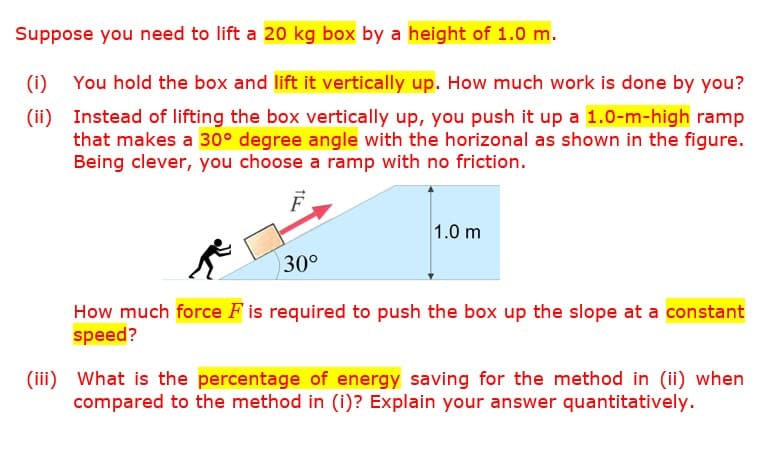Suppose you need to lift a 20 kg box by a height of 1.0 m. (i) You hold the box and lift it vertically up. How much work is done by you? (ii) Instead of lifting the box vertically up, you push it up a 1.0-m-high ramp that makes a 30° degree angle with the horizonal as shown in the figure. Being clever, you choose a ramp with no friction. 1.0 m 30° How much force F is required to push the box up the slope at a constant speed? (iii) What is the percentage of energy saving for the method in (ii) when compared to the method in (i)? Explain your answer quantitatively.
Suppose you need to lift a 20 kg box by a height of 1.0 m. (i) You hold the box and lift it vertically up. How much work is done by you? (ii) Instead of lifting the box vertically up, you push it up a 1.0-m-high ramp that makes a 30° degree angle with the horizonal as shown in the figure. Being clever, you choose a ramp with no friction. 1.0 m 30° How much force F is required to push the box up the slope at a constant speed? (iii) What is the percentage of energy saving for the method in (ii) when compared to the method in (i)? Explain your answer quantitatively.
An Introduction to Physical Science
14th Edition
ISBN:9781305079137
Author:James Shipman, Jerry D. Wilson, Charles A. Higgins, Omar Torres
Publisher:James Shipman, Jerry D. Wilson, Charles A. Higgins, Omar Torres
Chapter4: Work And Energy
Section: Chapter Questions
Problem 16SA: Two students throw identical snowballs from the same height; both snowballs having the same initial...
Related questions
Topic Video
Question
100%
For this the final answer should be zero? The work done should not change regardless of its directions?

Transcribed Image Text:Suppose you need to lift a 20 kg box by a height of 1.0 m.
(i) You hold the box and lift it vertically up. How much work is done by you?
(ii) Instead of lifting the box vertically up, you push it up a 1.0-m-high ramp
that makes a 30° degree angle with the horizonal as shown in the figure.
Being clever, you choose a ramp with no friction.
1.0 m
30°
How much force F is required to push the box up the slope at a constant
speed?
(iii) What is the percentage of energy saving for the method in (ii) when
compared to the method in (i)? Explain your answer quantitatively.
Expert Solution
This question has been solved!
Explore an expertly crafted, step-by-step solution for a thorough understanding of key concepts.
This is a popular solution!
Trending now
This is a popular solution!
Step by step
Solved in 5 steps

Knowledge Booster
Learn more about
Need a deep-dive on the concept behind this application? Look no further. Learn more about this topic, physics and related others by exploring similar questions and additional content below.Recommended textbooks for you

An Introduction to Physical Science
Physics
ISBN:
9781305079137
Author:
James Shipman, Jerry D. Wilson, Charles A. Higgins, Omar Torres
Publisher:
Cengage Learning

University Physics Volume 1
Physics
ISBN:
9781938168277
Author:
William Moebs, Samuel J. Ling, Jeff Sanny
Publisher:
OpenStax - Rice University

Glencoe Physics: Principles and Problems, Student…
Physics
ISBN:
9780078807213
Author:
Paul W. Zitzewitz
Publisher:
Glencoe/McGraw-Hill

An Introduction to Physical Science
Physics
ISBN:
9781305079137
Author:
James Shipman, Jerry D. Wilson, Charles A. Higgins, Omar Torres
Publisher:
Cengage Learning

University Physics Volume 1
Physics
ISBN:
9781938168277
Author:
William Moebs, Samuel J. Ling, Jeff Sanny
Publisher:
OpenStax - Rice University

Glencoe Physics: Principles and Problems, Student…
Physics
ISBN:
9780078807213
Author:
Paul W. Zitzewitz
Publisher:
Glencoe/McGraw-Hill

Principles of Physics: A Calculus-Based Text
Physics
ISBN:
9781133104261
Author:
Raymond A. Serway, John W. Jewett
Publisher:
Cengage Learning

Physics for Scientists and Engineers, Technology …
Physics
ISBN:
9781305116399
Author:
Raymond A. Serway, John W. Jewett
Publisher:
Cengage Learning

Physics for Scientists and Engineers: Foundations…
Physics
ISBN:
9781133939146
Author:
Katz, Debora M.
Publisher:
Cengage Learning